
セリア・クルスの人生
Life of Celia Cruz, 1925-2003

Cruz featured on a
2024 American Women quarter
☆ この解説は、スペイン語版(Wiki)からの翻訳版「セリア・クルス」の姉妹版である(→参照ページ「私の人生は歌うこと」)。
★セリア・クルスと
して知られるセリア・カリダ・クルス・アルフォンソ[a](1925年10月21日-2003年7月16日)は、キューバの歌手であり、
20世紀を代表するラテン・アーティストである。クルスは、1950年代にグアラチャの歌手としてキューバで有名になり、「ラ・グアラチェラ・デ・クー
バ」というニックネームを得た。その後数十年間、ラテン音楽への貢献により「サルサの女王」として国際的に知られるようになった[4][5][6]。
1,000万枚以上のレコードを売り上げ、最も売れたラテン音楽アーティストの一人となった[7]。
クルスは母国キューバでキャリアをスタートさせ、15年間(1950年~1965年)続いた人気音楽グループ、ソノラ・マタンセラのヴォーカリストとして
知られるようになった。クルスは、グアラチャ、ルンバ、アフロ、ソン、ボレロなど、アフロ・キューバン・ミュージックの幅広いスタイルをマスターし、これ
らのスタイルでシーコ・レコードに数多くのシングルを録音した。1960年、キューバ革命によって音楽産業がナショナリズム化された後、クルスは母国を離
れ、亡命キューバ人コミュニティのシンボルでありスポークスマンのひとりとなった[8]。1960年代にはティト・プエンテとコラボレートし、彼女の代表
曲「Bemba
colorá」をレコーディングした。1970年代にはファニア・レコードと契約し、サルサのジャンルと強く結びつき、「キンバラ」などのヒット曲を発表
した。ファニア・オールスターズのライブにしばしば出演し、ジョニー・パチェコやウィリー・コロンとコラボレートした。キャリア晩年のクルスは、「La
vida es un carnaval 」や 「La negra tiene tumbao 」などのヒット曲をリリースし続けた[9]。
彼女の音楽的遺産は、合計37枚のスタジオ・アルバムのほか、数多くのライブ・アルバムやコラボレーションで構成されている。そのキャリアを通じて、グラ
ミー賞2回、ラテン・グラミー賞3回など、数々の賞を受賞している。音楽活動だけでなく、クルスは女優としても映画やテレノベラに出演した。彼女のキャッ
チフレーズ「¡Azúcar! (「アスーカル(お砂糖)!」)は、サルサ・ミュージックの最もよく知られたシンボルのひとつとなっている。
| Cantar para mi, es cómo
ser Dueña del universo, Poder expresar con mi voz Lo que llevo por dentro. Hacerles a ustedes sentir Sensaciones grandiosas, Y en siete notas conjugar, Cantando muchas cosas. Y cuando la magia de algún son, Invade poco a poco el corazón, Me envuelvo con su ritmo sabroson, Y el sentimiento. Siento los cueros repicar Y mi cuerpo no cesa de bailar. Dejándome llevar por el compás, Que bien me siento. Y es que el canto, yo lo llevo por dentro. Cantando yo viajo al mundo, Brindándole sentimiento. Y es que el canto, yo lo llevo por dentro. Tres amores tengo dentro De mi alegre corazón. Y es que el canto, yo lo llevo por dentro. Cuba bella, el son la rumba Y mi cabecita de algodón. Y es que el canto, yo lo llevo por dentro. Lo que soy, es la gracia de dios. Su amor me dio este talento, Que te brindo con mi voz, con mi voz. - Celia Cruz - Mi Vida Es Cantar (1998) Celia Caridad Cruz Alfonso[a] (21 October 1925 – 16 July 2003), known as Celia Cruz, was a Cuban singer and one of the most popular Latin artists of the 20th century. Cruz rose to fame in Cuba during the 1950s as a singer of guarachas, earning the nickname "La Guarachera de Cuba". In the following decades, she became known internationally as the "Queen of Salsa" due to her contributions to Latin music.[4][5][6] She had sold over 10 million records, making her one of the best-selling Latin music artists.[7] The artist began her career in her home country Cuba, earning recognition as a vocalist of the popular musical group Sonora Matancera, a musical association that lasted 15 years (1950–1965). Cruz mastered a wide variety of Afro-Cuban music styles including guaracha, rumba, afro, son and bolero, recording numerous singles in these styles for Seeco Records. In 1960, after the Cuban Revolution caused the nationalization of the music industry, Cruz left her native country, becoming one of the symbols and spokespersons of the Cuban community in exile.[8] Cruz continued her career, first in Mexico, and then in the United States, the country that she took as her definitive residence. In the 1960s, she collaborated with Tito Puente, recording her signature tune "Bemba colorá". In the 1970s, she signed for Fania Records and became strongly associated with the salsa genre, releasing hits such as "Quimbara". She often appeared live with Fania All-Stars and collaborated with Johnny Pacheco and Willie Colón. During the last years of her career, Cruz continued to release successful songs such as "La vida es un carnaval" and "La negra tiene tumbao".[9] Her musical legacy is made up of a total of 37 studio albums, as well as numerous live albums and collaborations. Throughout her career, she was awarded numerous prizes and distinctions, including two Grammy Awards and three Latin Grammy Awards. In addition to her prolific career in music, Cruz also made several appearances as an actress in movies and telenovelas. Her catchphrase "¡Azúcar!" ("Sugar!") has become one of the most recognizable symbols of salsa music. |
歌うことは、私にとって 宇宙の女王になるようなもの。 声で表現できること、 心に抱えているものを あなたに感じさせること、 素晴らしい感覚を 与えること、7つの音符を組み合わせること、 さまざまなことを歌うこと。 そして、ある歌の魔法が 少しずつ心に浸透してくると、 私はそのリズムと感覚に身をゆだねる。 そして、肌が共鳴し そして、私の体は踊り続ける。 リズムに身を任せ、 なんと気持ちが良いことか。 そして、私は歌を心に秘めている。 歌いながら世界中を旅し、 その気持ちを伝える。 そして、私は歌を心に秘めている。 私の心には3つの愛がある 喜びの心。 そして、私は歌を心に秘めている。 美しいキューバ、ルンバの息子 そして、私の小さな綿毛の頭。 そして、歌うことで、私はそれを心に抱いている。 私が何者であるかといえば、それは神の恵みだ。 神の愛が私にこの才能を与えてくれた。 私はこの才能を、私の声で、あなたに捧げる。私の声で。 - Celia Cruz - Mi Vida Es Cantar (1998) セリア・クルスとして知られるセリア・カリダ・クルス・アルフォンソ[a](1925年10月21日-2003年7月16日)は、キューバの歌手であり、 20世紀を代表するラテン・アーティストである。クルスは、1950年代にグアラチャの歌手としてキューバで有名になり、「ラ・グアラチェラ・デ・クーバ 」というニックネームを得た。その後数十年間、ラテン音楽への貢献により「サルサの女王」として国際的に知られるようになった[4][5][6]。 1,000万枚以上のレコードを売り上げ、最も売れたラテン音楽アーティストの一人となった[7]。 クルスは母国キューバでキャリアをスタートさせ、15年間(1950年~1965年)続いた人気音楽グループ、ソノラ・マタンセラのヴォーカリストとして 知られるようになった。クルスは、グアラチャ、ルンバ、アフロ、ソン、ボレロなど、アフロ・キューバン・ミュージックの幅広いスタイルをマスターし、これ らのスタイルでシーコ・レコードに数多くのシングルを録音した。1960年、キューバ革命によって音楽産業がナショナリズム化された後、クルスは母国を離 れ、亡命キューバ人コミュニティのシンボルでありスポークスマンのひとりとなった[8]。1960年代にはティト・プエンテとコラボレートし、彼女の代表 曲「Bemba colorá」をレコーディングした。1970年代にはファニア・レコードと契約し、サルサのジャンルと強く結びつき、「キンバラ」などのヒット曲を発表 した。ファニア・オールスターズのライブにしばしば出演し、ジョニー・パチェコやウィリー・コロンとコラボレートした。キャリア晩年のクルスは、「La vida es un carnaval 」や 「La negra tiene tumbao 」などのヒット曲をリリースし続けた[9]。 彼女の音楽的遺産は、合計37枚のスタジオ・アルバムのほか、数多くのライブ・アルバムやコラボレーションで構成されている。そのキャリアを通じて、グラ ミー賞2回、ラテン・グラミー賞3回など、数々の賞を受賞している。音楽活動だけでなく、クルスは女優としても映画やテレノベラに出演した。彼女のキャッ チフレーズ「¡Azúcar! (「アスーカル(お砂糖)!」)は、サルサ・ミュージックの最もよく知られたシンボルのひとつとなっている。 |
| Early life Celia Caridad Cruz Alfonso was born on 21 October 1925, at 47 Serrano Street in the Santos Suárez neighborhood of Havana, Cuba.[10][3][11] Her father, Simón Cruz, was a railway stoker, and her mother, Catalina Alfonso Ramos, a housewife of Haitian descent who took care of an extended family.[3] Celia was one of the eldest among fourteen children living in the house, including cousins and her three siblings, Dolores, Gladys, and Bárbaro,[12][13] and she used to sing cradle songs to put them to sleep.[11] According to her mother, she began singing as a child at 9 or 10 months of age, often in the middle of the night.[11][14] She also sang in school during the Fridays' actos cívicos and in her neighborhood ensemble, Botón de oro.[11] While growing up in Cuba's diverse 1930s musical climate, Cruz listened to many musicians who influenced her adult career, including Fernando Collazo, Abelardo Barroso, Pablo Quevedo, Antonio Arcaño and Arsenio Rodríguez.[6] Despite her father's opposition and the fact that she was Catholic, as a child Cruz learned Santería songs from her neighbor who practiced Santería.[15] Cruz also studied the words to Yoruba songs with colleague Merceditas Valdés (an akpwon, a Santería singer) from Cuba and later made various recordings of this religious genre, even singing backup for other akpwons like Candita Batista. As a teenager, her aunt took her and her cousin to cabarets to sing, but her father encouraged her to attend school in the hope she would become a teacher. After high school, she attended the Normal School for Teachers in Havana with the intent of becoming a literature teacher.[16] At the time being a singer was not viewed as an entirely respectable career. However, one of her teachers told her that, as an entertainer, she could earn in one day what most Cuban teachers earned in a month. From 1947, Cruz studied music theory, voice, and piano at Havana's National Conservatory of Music.[17] One day, her cousin took her to Havana's radio station Radio García-Serra, where she became a contestant in the "Hora del té" amateur radio program. It was her first time using a microphone and she sang the tango "Nostalgia" (as a tribute to Paulina Álvarez[6]), winning a cake as the first prize for her performance.[11] On other occasions she won silver chains, as well as opportunities to participate in more contests.[18] She also sang in other amateur radio programs such as La suprema corte del arte, broadcast by CMQ, always winning first prize. The only exception was when she competed against Vilma Valle, having to split their earnings: 25 dollars each.[11] In 2004, the Miami Herald revealed from partially declassified US State Department papers that Cruz had been linked to Cuba's pre-Revolution communist party, the Popular Socialist Party (PSP), as early as the 1940s.[19] The article, promoted as an "exclusive", was written by Miami Herald journalist Carol Rosenberg from Freedom of Information Act requests. It made several revelations. Among them, the US Embassy in Havana denied Cruz a US visa in 1952 and 1955 because of suspected communist affiliations. The article also states that Cruz had joined the youth wing of the PSP at age 20 and had used a concert to arrange a secret meeting with communists in South America on behalf of its then general secretary, Blas Roca Calderío, who has also founded the party in 1925. Cruz had also signed a public letter in support of one of the Party's front groups, the Pro-Peace Congress. The article states that Cruz's surviving husband, Pedro Knight, was asked about this, and is quoted he knew nothing about it. "She never told me about that. She never talked about politics," the article quotes Knight.[20] |
生い立ち セリア・カリダ・クルス・アルフォンソは1925年10月21日、キューバ・ハバナのサントス・スアレス地区のセラノ通り47番地で生まれた[10] [3][11]。父のシモン・クルスは鉄道のストーカーであり、母のカタリナ・アルフォンソ・ラモスはハイチ系の主婦で、大家族の面倒を見ていた。 [セリアは、いとこやドロレス、グラディス、バルバロの3人の兄弟を含む14人の子供たちの長女の一人であり[12][13]、子供たちを寝かしつけるた めにゆりかごの歌を歌っていた。 [11]母親によると、彼女は生後9、10ヶ月の頃から歌い始め、しばしば夜中に歌っていた[11][14]。また、学校では金曜日のアクトス・シビコス の時間に歌い、近所のアンサンブル、ボトン・デ・オロでも歌っていた[11]。 1930年代のキューバの多様な音楽的風土の中で育ったクルスは、フェルナンド・コラソ、アベラルド・バロソ、パブロ・ケベド、アントニオ・アルカー ニョ、アルセニオ・ロドリゲスなど、彼女の成人後のキャリアに影響を与えた多くのミュージシャンを聴いた[6]。父親の反対や彼女がカトリック信者であっ たにもかかわらず、クルスは子供の頃、サンテリアを練習していた隣人からサンテリアの歌を学んだ。 [15]クルスはまた、キューバの同僚であるメルセディタス・バルデス(アクプウォン、サンテリアの歌手)と一緒にヨルバの歌の歌詞を勉強し、後にこの宗 教ジャンルの様々なレコーディングを行い、キャンディータ・バティスタのような他のアクプウォンのバックで歌ったりもした。 10代の頃、叔母に連れられて従姉妹とキャバレーで歌っていたが、父親が教師になるために学校に通うよう勧めた。高校卒業後、彼女は文学の教師になる意図 主義で、ハバナの師範学校に通った[16]。しかし、ある教師は、エンターテイナーとして、ほとんどのキューバの教師が1ヶ月で稼ぐ額を1日で稼ぐことが できると彼女に言った。1947年から、クルスはハバナのナショナリズム音楽院で音楽理論、声楽、ピアノを学んだ[17]。 ある日、いとこに連れられてハバナのラジオ局Radio García-Serraに行き、そこでアマチュアラジオ番組 「Hora del té 」の出場者となる。マイクを使うのは初めてで、タンゴの「ノスタルジア」(パウリーナ・アルバレス[6]へのオマージュ)を歌い、優勝賞品としてケーキを 獲得した。唯一の例外は、ヴィルマ・バジェと競ったときで、25ドルずつ折半しなければならなかった[11]。 2004年、『マイアミ・ヘラルド』紙は、一部機密解除されたアメリカ国務省の文書から、クルスが1940年代からキューバの革命前の共産党、人民社会党 (PSP)とつながっていたことを明らかにした[19]。その中でいくつかの事実が明らかになった。その中で、ハバナのアメリカ大使館は1952年と 1955年に、共産主義者との関係が疑われたため、クルスにアメリカのビザを発給しなかった。また、クルスは20歳でPSPの青年団に参加し、1925年 に同党を創設した当時の書記長ブラス・ロカ・カルデリオに代わって、南米の共産主義者との秘密会談を手配するためにコンサートを利用したと書かれている。 クルスはまた、党のフロントグループのひとつである「親平和会議」を支持する公文書にも署名していた。この記事によれば、クルスが遺された夫のペドロ・ナ イトはこの件について質問され、何も知らなかったと答えたという。「彼女はそのことを私に話さなかった。彼女は政治の話は一切しなかった」と記事はナイト の言葉を引用している[20]。 |
Career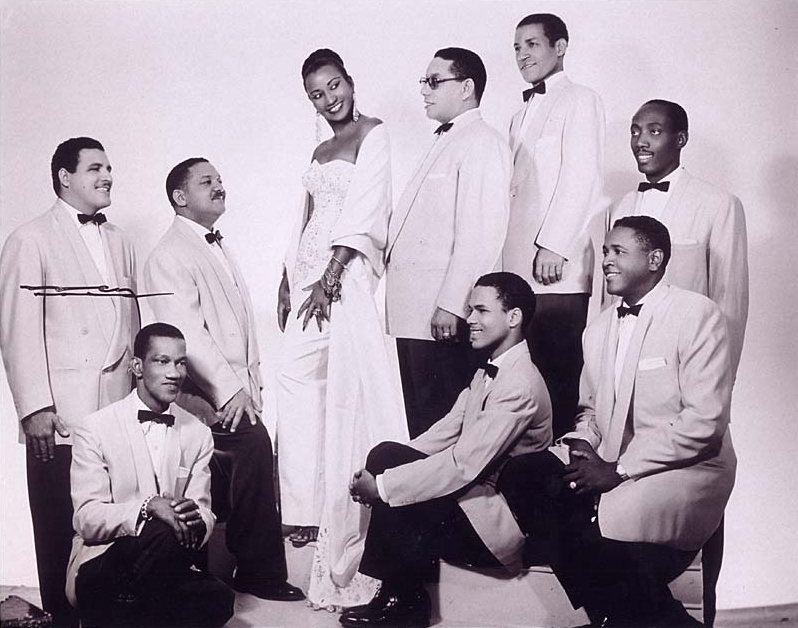 Celia Cruz in the 1950s with the members of the Sonora Matancera in Havana First recordings Isolina Carrillo was one of the first people to recognize Cruz's ability to sing Afro-Cuban music and asked her to join her Conjunto Siboney, where Olga Guillot also sang.[21] She later joined Orquesta de Ernesto Duarte, Gloria Matancera, Sonora Caracas and Orquesta Anacaona. From 1947, she started to sing in Havana's most popular cabarets: Tropicana, Sans Souci, Bamboo, Topeka, etc.[11] In 1948, Roderico Rodney Neyra founded the group of dancers and singers Las Mulatas de Fuego (The Fiery Mulattas).[22][23][24] Cruz was hired with this group as a singer, reaching great success and making presentations in Mexico and Venezuela, where she made her first recordings. Shortly thereafter, Cruz began to sing on musical programs at Radio Cadena Suaritos, along with a group that performed Santería music under the direction of Obdulio Morales. With this group, known as Coro Yoruba y Tambores Batá, she made several recordings that were later released by Panart. |
経歴 1950年代、ハバナでソノラ・マタンセラのメンバーと共演したセリア・クルス 最初のレコーディング イソリーナ・カリージョは、クルスのアフロ・キューバン・ミュージックの歌唱力を最初に見出した人物の一人で、オルガ・ギヨも歌っていたコンジュント・シ ボニーへの参加を依頼した[21]。その後、オルケスタ・デ・エルネスト・ドゥアルテ、グロリア・マタンセラ、ソノラ・カラカス、オルケスタ・アナカオナ に参加。1947年からは、ハバナで最も人気のあるキャバレーで歌うようになる: 1948年、ロデリコ・ロドニー・ネイラがダンサーと歌手のグループ、ラス・ムラタス・デ・フエゴ(火のようなムラタたち)を結成。[22][23] [24] クルスはこのグループに歌手として雇われ、大きな成功を収め、メキシコとベネズエラで公演を行い、そこで初めてレコーディングを行った。その後まもなく、 クルスはラジオ・カデナ・スアリトスの音楽番組で、オブドゥリオ・モラレスの指揮のもとサンテリア音楽を演奏するグループとともに歌うようになる。コー ロ・ヨルバ・イ・タンボレス・バタとして知られるこのグループで、後にパナートからリリースされたいくつかのレコーディングを行った。 |
| Sonora Matancera Cruz's big break came in 1950 when Myrta Silva, the singer with Cuba's Sonora Matancera, returned to her native Puerto Rico. Since they were in need of a new singer, the band decided to give the young Celia Cruz a chance. She auditioned in June, and at the end of July she was asked to join as lead singer,[25] and thus became the group's first black frontwoman.[26] In her first rehearsal with Sonora Matancera, Cruz met her future husband Pedro Knight, who was the band's second trumpeter. Cruz debuted with the group on 3 August 1950. Initially, Cruz was not received with enthusiasm by the public, but Rogelio Martínez had faith in her. On 15 December 1950, Cruz recorded her first songs with the group, which were a resounding success. Her "musical marriage" with the Sonora Matancera lasted fifteen years. In total Celia recorded 188 songs with the Matancera, including hits such as "Cao cao maní picao", "Mata siguaraya", "Burundanga" and "El yerbero moderno". She won her first gold record for "Burundanga", making her first trip to the United States in 1957 to receive the award and to perform at St. Nicholas Arena, New York.[11] During her 15 years with Sonora Matancera, she appeared in cameos in some Mexican films such as Rincón criollo (1950), Una gallega en La Habana (1955) and Amorcito corazón (1961), toured all over Latin America and became a regular at the Tropicana. |
ソノラ・マタンセラ クルスが大ブレイクしたのは1950年、キューバのソノラ・マタンセラのシンガー、ミルタ・シルヴァが故郷プエルトリコに戻った時だった。新しいシンガー を必要としていたバンドは、若いセリア・クルスにチャンスを与えることにした。彼女は6月にオーディションを受け、7月末にリード・シンガーとして加入を 要請され[25]、グループ初の黒人フロントウーマンとなった[26]。ソノラ・マタンセラとの最初のリハーサルで、クルスはバンドの2代目トランペッ ターであった将来の夫ペドロ・ナイトに出会った。 クルスは1950年8月3日にデビューした。当初、クルスは大衆から熱狂的に迎えられることはなかったが、ロジェリオ・マルティネスは彼女を信頼してい た。1950年12月15日、クルスはグループとの最初のレコーディングを行い、大成功を収めた。ソノラ・マタンセラとの 「音楽的結婚 」は15年間続いた。セリアはマタンセラで合計188曲を録音し、その中には 「Cao cao maní picao」、「Mata siguaraya」、「Burundanga」、「El yerbero moderno 」といったヒット曲が含まれている。ブルンダンガ 「で初のゴールド・レコードを獲得し、1957年には受賞とニューヨークのセント・ニコラス・アリーナでの公演のために初めて渡米した[11]。ソノラ・ マタンセラに在籍した15年間、」Rincón criollo「(1950)、」Una gallega en La Habana「(1955)、」Amorcito corazón"(1961)などのメキシコ映画にカメオ出演し、ラテン・アメリカ全土をツアーし、トロピカーナの常連となった。 |
| Exile and Tico recordings Cruz was touring in Mexico when Fidel Castro seized power at the conclusion of the Cuban Revolution. She returned to Cuba to find her hometown of Havana in turmoil and mostly shut down.[27] Cruz was publicly critical of Castro, a stance that she knew would endanger her career and possibly her freedom, since other critics of the regime were regularly arrested. She also needed money to pay for her ailing mother's medical expenses, and when she was offered a contract to perform for a few months at La Terraza Nightclub in Mexico City, she accepted. Cruz left Cuba on 15 July 1960, not knowing that she would likely never return to her home country.[28] Just one week after arriving in Mexico, Cruz received the news of the death of her father, Simón Cruz. In 1961, Cruz and Sonora Matancera left Mexico for an engagement in the United States. During this period, Cruz began performing solo without the group, performing at a recital at the Hollywood Palladium in Los Angeles. In 1962, before the refusal of the Cuban government to allow her to return to Cuba, Cruz acquired a house in Fort Lee, New Jersey. Although she tried to return to Cuba to see her sick mother, who was struggling with terminal bladder cancer, the Cuban government denied her request to return.[29] On 7 April 1962, she received the news of the death of her mother Catalina Alfonso. That same year, on 14 July, Cruz was married in civil ceremony with Pedro Knight after a romance of several years. Cruz and Sonora Matancera made their first tour outside of the Americas, visiting Europe and Japan, where they performed with Tito Puente. In 1965, Cruz would culminate a vertiginous fifteen years with the Sonora Matancera. Cruz began a solo career and her husband Pedro Knight decided to leave his position at Sonora Matancera to become her representative, arranger and personal director. During this time, Cruz became an American citizen. In 1966, Cruz was contacted by Tito Puente to perform with his orchestra. Their first collaborative album, Son con guaguancó featured a recording of José Claro Fumero's guaracha "Bemba colorá", which became one of Cruz's signature songs.[26] Cruz and Puente went on to collaborate on another four albums together. She also recorded albums with other musical directors such as Memo Salamanca, Juan Bruno Tarraza and Lino Frías for Tico Records. In 1974, Fania Records, the leading salsa record label, acquired Tico and signed Cruz to the imprint Vaya Records, where she remained until 1992. |
亡命とティコのレコーディング キューバ革命が終結し、フィデル・カストロが権力を掌握したとき、クルスはメキシコでツアーを行っていた。クルスは公にカストロに批判的であったが、その 姿勢は彼女のキャリアを危険にさらし、場合によっては自由を失うことになるとわかっていた。彼女はまた、病弱な母親の医療費を支払うためにお金が必要であ り、メキシコシティのラ・テラサ・ナイトクラブで数ヶ月間パフォーマビティをする契約を持ちかけられ、それを受け入れた。クルスは1960年7月15日に キューバを出発したが、母国に戻ることはないだろうとは思っていなかった[28]。 メキシコに到着してわずか1週間後、クルスは父シモン・クルスの訃報を受ける。1961年、クルスとソノラ・マタンセラはアメリカでの婚約のためにメキシ コを離れた。この時期、クルスはグループを離れてソロ活動を始め、ロサンゼルスのハリウッド・パラディウムでリサイタルを開いた。 1962年、キューバ政府がキューバへの帰国を拒否する前に、クルスはニュージャージー州フォートリーに家を手に入れた。1962年4月7日、母カタリ ナ・アルフォンソの訃報を受ける。同年7月14日、クルスは数年にわたるロマンスの末、ペドロ・ナイトと市民結婚式を挙げた。クルスとソノラ・マタンセラ は初のアメリカ大陸外ツアーを行い、ヨーロッパと日本を訪れ、ティト・プエンテと共演した。1965年、クルスはソノラ・マタンセラとともに歩んだ15年 間の頂点に立つ。クルスはソロ活動を始め、夫のペドロ・ナイトはソノラ・マタンセラの職を離れ、彼女の代理人、アレンジャー、個人ディレクターになること を決めた。この間にクルスはアメリカ国籍を取得した。 1966年、クルスはティト・プエンテから彼のオーケストラと共演しないかと打診された。最初のコラボレーション・アルバム『Son con guaguancó』には、クルスを代表する曲のひとつとなったホセ・クラロ・フメロのグアラチャ「Bemba colorá」が収録されている[26]。また、ティコ・レコードでは、メモ・サラマンカ、フアン・ブルーノ・タラサ、リノ・フリアスといった他の音楽監 督ともアルバムを録音している。1974年、サルサ・レコードの大手レーベル、ファニア・レコードがティコを買収し、クルスはヴァヤ・レコードと契約、 1992年まで在籍した。 |
The Fania years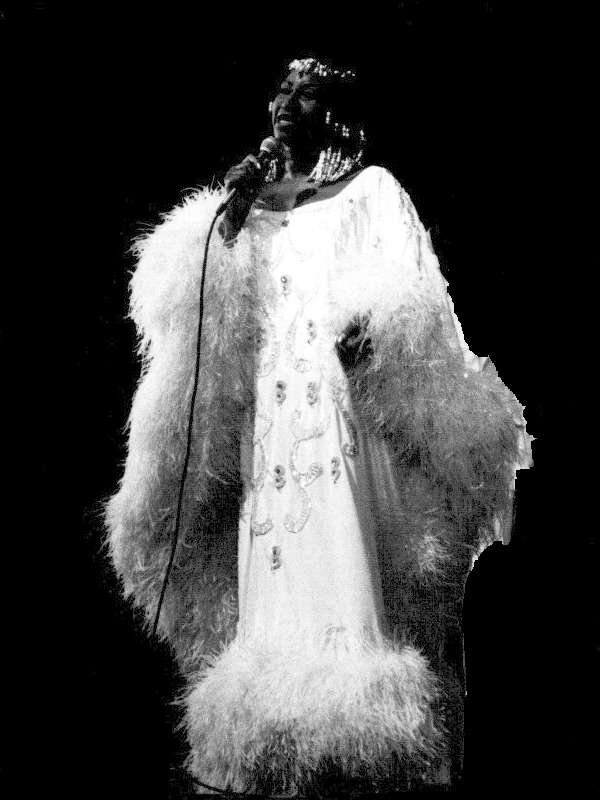 Celia Cruz performing in Paris at the Olympia in 1980 Cruz's association with the Fania label had begun in 1973, when she recorded the lead vocals of "Gracia divina", a song by Larry Harlow which was part of his "Latin opera" Hommy. She then joined the Fania All-Stars, a salsa supergroup featuring the most popular performers of the Fania roster. With them, Cruz first sang "Bemba colorá" and "Diosa del ritmo" in San Juan, Puerto Rico in 1973. She later travelled with the group to Kinshasa, Zaire, in 1974 and returned to San Juan in 1975 for another concert. These live recordings were commercially released years later. Her performance in Zaire, as part of The Rumble in the Jungle event, was included in the film Soul Power.[30] Cruz recorded her first studio album for Fania in 1974 in collaboration with Johnny Pacheco, the label's founder and musical director. The album, Celia & Johnny, and its lead single, "Quimbara", were both a commercial success. In 1976, she participated in the documentary film Salsa about Latin culture, along with figures like Dolores del Río and Willie Colón. The following year she recorded her first LP with Colón, a collaboration that would be repeated with great success in 1981 and 1987. When touring with Colón, Cruz wore a flamboyant costume, which included various colored wigs, tight sequined dresses, and very high heels. Her fashion style became so famous that one of them was acquired by the Smithsonian institution.[16] In the late 1970s, she participated in an Eastern Air Lines commercial in Puerto Rico, singing the catchy phrase ¡Esto sí es volar! (This is to truly fly!). Cruz also used to sing the identifying spot for WQBA radio station in Miami, formerly known as "La Cubanísima": "I am the voice of Cuba, from this land, far away...I am liberty, I am WQBA, the most Cuban!" (Yo soy de Cuba, la voz, desde esta tierra lejana... ¡soy libertad, soy WQBA, Cubanísima!). In 1982, Celia was reunited with the Sonora Matancera and recorded the album Feliz Encuentro. That year, the singer received the first tribute of her career at Madison Square Garden in New York. In 1987, Cruz performed a concert in Santa Cruz de Tenerife. That concert was recognized by the publisher of the Guinness Book of Records as the largest free-entry outdoor concert, with an audience of 250,000 people. In 1988, she participated in the feature film Salsa alongside Robby Draco Rosa. In 1990, Cruz won her first Grammy Award (Best Tropical Latin Performance) for her album Ritmo en el corazón, recorded with Ray Barretto. She was also invited to celebrate the 65th anniversary of the Sonora Matancera in Central Park in New York. The decline of Fania's brand of salsa dura in favor of the emergent salsa romántica gradually brought an end to Celia's musical association with the Fania All Stars. Their final reunions took place in Puerto Rico (1994) and Colombia (1995), both of which were released on CD. |
ファニア時代 1980年、パリのオリンピアでパフォーマンスするセリア・クルス クルスとファニア・レーベルとの付き合いは1973年に始まり、ラリー・ハーロウの 「ラテン・オペラ 」ホミーの一曲、「Gracia divina 」のリード・ヴォーカルを担当した。その後、彼女はファニア・オールスターズという、ファニアの人気パフォーマーを集めたサルサ・スーパーグループに参加 した。彼らとクルスは、1973年にプエルトリコのサンフアンで「Bemba colorá」と「Diosa del ritmo」を初めて歌った。その後、1974年にザイールのキンシャサを訪れ、1975年にはサンファンに戻ってコンサートを行った。これらのライブ録 音は数年後に市販された。ザイールでの彼女のパフォーマティビティは、『ランブル・イン・ザ・ジャングル』(The Rumble in the Jungle)のイベントの一部として、映画『ソウル・パワー』(Soul Power)に収録された[30]。 クルスは1974年、レーベルの創設者であり音楽監督でもあるジョニー・パチェコと共同で、ファニアのために初のスタジオ・アルバムをレコーディングし た。このアルバム『Celia & Johnny』とリード・シングル「Quimbara」は商業的に成功した。1976年には、ドロレス・デル・リオやウィリー・コロンらとともに、ラテン 文化に関するドキュメンタリー映画『サルサ』に参加した。翌年、彼女はコロンと最初のLPをレコーディングし、このコラボレーションは1981年と 1987年にも繰り返され、大成功を収めた。コロンとのツアーの際、クルスは様々な色のカツラ、スパンコールのついたタイトなドレス、とても高いヒールな ど、派手な衣装を身に着けていた。1970年代後半、彼女はプエルトリコでイースタン航空のコマーシャルに参加し、¡Esto sí es volar(これは本当に飛ぶこと!)というキャッチーなフレーズを歌った!(これは本当に飛ぶことだ!)というキャッチーなフレーズを歌った。クルスは また、以前は 「La Cubanísima 」として知られていたマイアミのWQBAラジオ局の識別スポットを歌っていた: 「私はキューバの声、この地から、遠く離れて...私は自由、私はWQBA、最もキューバらしい!"(Yo soy de Cuba, la la Cubanísima! (Yo soy de Cuba, la voz, desde esta tierra lejana... ¡soy libertad, soy WQBA, Cubanísima!)。 1982年、セリアはソノラ・マタンセラと再結成し、アルバム『Feliz Encuentro』を録音した。同年、ニューヨークのマディソン・スクエア・ガーデンでキャリア初のトリビュートを受けた。1987年、クルスはサン タ・クルス・デ・テネリフェでコンサートを行った。このコンサートは、入場無料の野外コンサートとしては最大規模の25万人を動員し、ギネスブックに認定 された。1988年には、ロビー・ドラコ・ロサと共に長編映画『サルサ』に参加した。1990年、クルスはレイ・バレットと録音したアルバム『Ritmo en el corazón』で初のグラミー賞(最優秀トロピカル・ラテン・パフォーマンス賞)を受賞した。また、ニューヨークのセントラルパークで開催されたソノ ラ・マタンセラ65周年記念式典に招待された。ファニアのサルサ・ドゥーラが衰退し、サルサ・ロマンティカが台頭してきたことで、セリアとファニア・オー ル・スターズとの音楽的な交流は次第に途絶えていった。最後の再結成はプエルトリコ(1994年)とコロンビア(1995年)で行われ、いずれもCDでリ リースされた。 |
Later years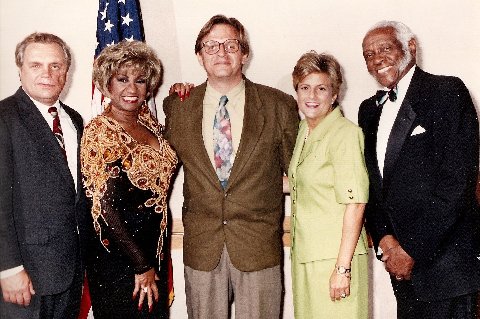 Dexter Lehtinen, Celia Cruz, Alonso R. del Portillo, Rep. Ileana Ros-Lehtinen, and Pedro Knight in May 1992 In 1990, Cruz managed to return to Cuba. She was invited to make a presentation at the Guantanamo Bay Naval Base. When she came out of this presentation she took a few grams of Cuban soil in a bag; at her request, this bag would later be placed in her coffin when she died. In 1994, she received the National Endowment for the Arts award from the then President Bill Clinton, which is the highest recognition granted by the United States government to an artist.[31] Having made musical presentations in Mexican and Cuban films, in 1992 Celia participated as an actress in the American film Mambo Kings, along with Armand Assante and Antonio Banderas. A year later she made her debut as a television actress in the Mexican telenovela Valentina, along with Verónica Castro for the Televisa network. In 1995, Celia made a guest appearance in the American film The Perez Family, along with Alfred Molina and Anjelica Huston. In 1997, she starred again for Televisa in the Mexican telenovela El alma no tiene color, a remake of the classic Mexican film Angelitos negros. Cruz played the role of a black woman who gives birth to a white daughter. On 25 October 1997, the city of San Francisco, California, officially declared that date as "Celia Cruz Day". In 1998, she released the album Mi vida es cantar, which featured one of her most successful songs, La vida es un carnaval. In 1999, she performed with Luciano Pavarotti for the Pavarotti and Friends concert. In 2000, Cruz released a new album under the auspices of Sony Music, Celia Cruz and Friends: A Night of Salsa, where she recorded again with Tito Puente, who died shortly after. Thanks to this album, Cruz was awarded her first Latin Grammy. In 2001, the album Siempre viviré won her a second Latin Grammy. In that same year, she performed with Marc Anthony in a tribute to Aretha Franklin for VH1. In 2002, Cruz released the album, La negra tiene tumbao, where she ventured into modern variants of Caribbean rhythms, influenced by rap and hip hop. For this record she won her third Latin Grammy and her second American Grammy. On 16 July 2002, Cruz performed to a full house at the free outdoor performing arts festival Central Park SummerStage in New York City. During the performance she sang "Bemba colorá". A live recording of this song was subsequently made available in 2005 on a commemorative CD honoring the festival's then 20-year history entitled, "Central Park SummerStage: Live from the Heart of the City". Cruz appeared on the Dionne Warwick albums Dionne Sings Dionne and My Friends & Me with their Latin duet version of "(Do You Know The Way To) San José". |
その後 1992年5月、デクスター・レティネン、セリア・クルス、アロンソ・R・デルポルティージョ、イリアナ・ロス・レティネン下院議員、ペドロ・ナイト 1990年、クルスはキューバに戻ることができた。彼女はグアンタナモ湾海軍基地でのプレゼンテーションに招待された。このプレゼンテーションの後、彼女 は数グラムのキューバの土を袋に入れて持ち帰った。彼女の希望で、この袋は後に彼女が亡くなった時に棺に入れられることになった。1994年、当時のビ ル・クリントン大統領から、アメリカ政府が芸術家に与える最高の賞であるナショナリズム賞を受賞した[31]。メキシコ映画やキューバ映画で音楽活動を 行ったセリアは、1992年、アルマンド・アサンテやアントニオ・バンデラスとともに、アメリカ映画『マンボ・キングス』に女優として出演。その1年後、 メキシコのテレヴィサ・ネットワークのテレノヴェラ『バレンティーナ』で、ベロニカ・カストロとともにテレビ女優としてデビューした。1995年には、ア ルフレッド・モリーナ、アンジェリカ・ヒューストンとともにアメリカ映画『ペレス・ファミリー』にゲスト出演した。1997年、メキシコの名作映画 『Angelitos negros』のリメイクであるメキシコのテレノベラ『El alma no tiene color』に再び出演した。クルスは、白人の娘を出産する黒人女性の役を演じた。1997年10月25日、カリフォルニア州サンフランシスコ市はその日 を「セリア・クルス・デー」と公式に宣言した。 1998年、アルバム『Mi vida es cantar』をリリースし、代表曲のひとつ『La vida es un carnaval』を歌う。1999年、ルチアーノ・パヴァロッティと「パヴァロッティ&フレンズ」コンサートに出演した。2000年、クルスはソニー・ ミュージックから新しいアルバム『セリア・クルス&フレンズ』をリリースした: A Night of Salsa』(サルサの夜)をリリースし、直後に亡くなったティト・プエンテと再びレコーディングを行った。このアルバムのおかげで、クルスは自身初のラ テン・グラミー賞を受賞した。2001年、アルバム『Siempre viviré』で2度目のラテン・グラミー賞を受賞した。同年、VH1のアレサ・フランクリンへのトリビュートでマーク・アンソニーと共演した。2002 年、クルスはアルバム『La negra tiene tumbao』をリリースし、ラップやヒップホップの影響を受けながら、カリブのリズムをモダンにアレンジした。このアルバムで3度目のラテン・グラミー 賞と2度目のアメリカ・グラミー賞を受賞した。 2002年7月16日、クルスはニューヨークの無料野外パフォーミング・アート・フェスティバル、セントラルパーク・サマーステージで満員の観客を前にパ フォーマンスを行った。パフォーマティビティでは「Bemba colorá」を歌った。この曲のライブ・レコーディングは、2005年、当時20年の歴史を持つこのフェスティバルを記念したCD『Central Park SummerStage』として発売された: Live from the Heart of the City "と題された。クルスは、ディオンヌ・ワーウィックのアルバム『Dionne Sings Dionne』と『My Friends & Me』に、ラテン・デュエット・バージョンの「(Do You Know The Way To) San José」で参加している。 |
Death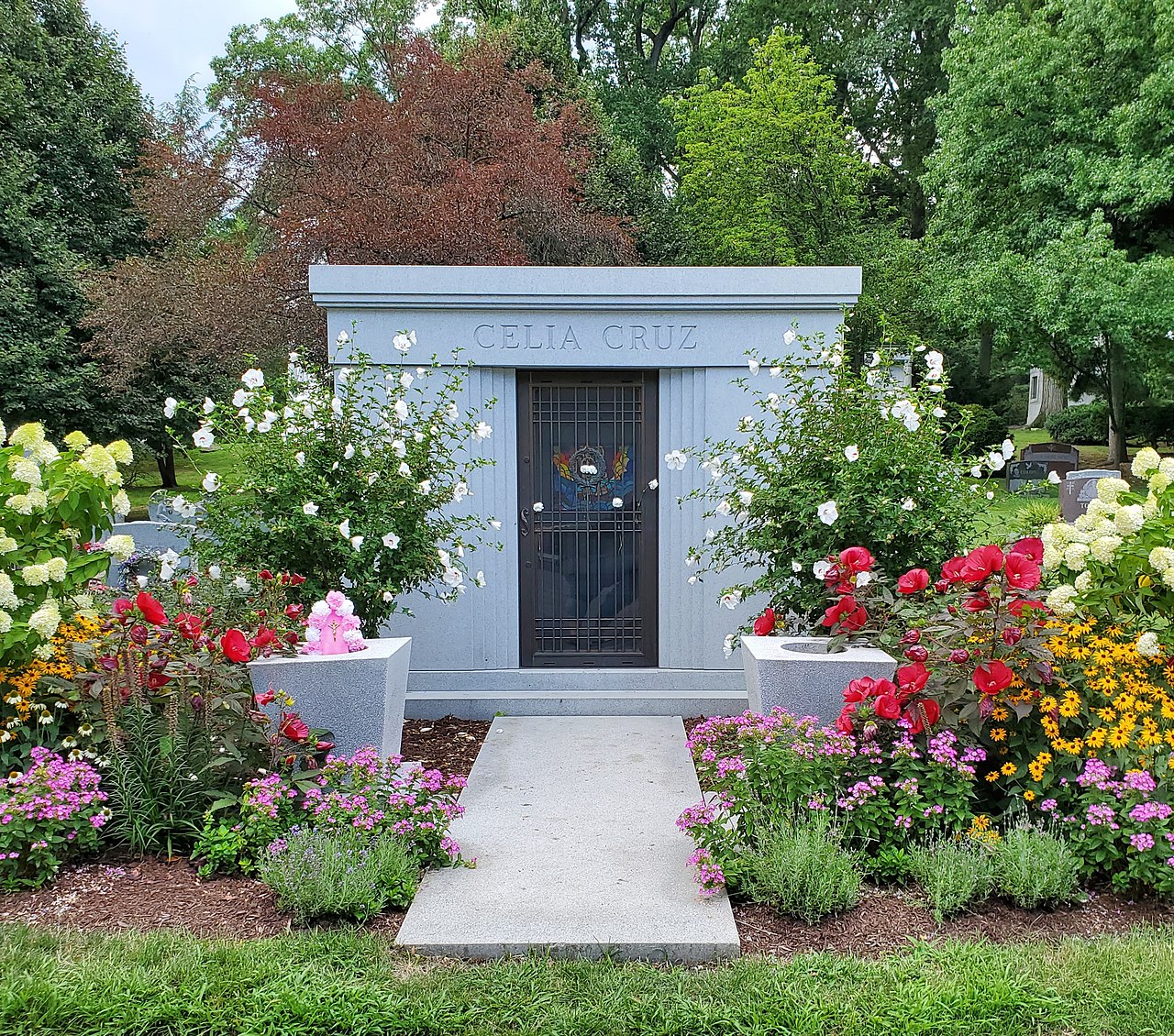 Celia Cruz's mausoleum in Woodlawn Cemetery, The Bronx, New York In August and September 2002, Cruz underwent surgery due to breast cancer.[32] In November that year, Cruz fell during a concert in Mexico. She was diagnosed with glioma, an aggressive form of brain cancer, and underwent surgery in December.[32] Confident, Cruz said she did not shed one tear and that she was aiming to resume her artistic career.[32] She finished recording her last album, Regalo del Alma. In February, she appeared in public again at the 45th Annual Grammy Awards to receive the award for Best Salsa Album.[32] In March 2003, the US Hispanic network Telemundo paid tribute to her. The event, titled ¡Celia Cruz: Azúcar!, involved figures such as Gloria Estefan, Marc Anthony, La India, Gloria Gaynor and Patti LaBelle among others.[33][34] This was her last public appearance. On the afternoon of 16 July 2003, Cruz died at her home in Fort Lee, New Jersey, at the age of 77. At her express wish, her mortal remains were first transferred to Miami for two days to receive the homage of her Cuban exile admirers at Gesu Church, before a funeral Mass at St. Patrick's Cathedral and burial in the Woodlawn Cemetery in The Bronx, New York.[35][36][37][38][39] An epilogue in her autobiography notes that, in accordance with her wishes, Cuban soil - which she had saved from a visit to Guantánamo Bay - was used in her entombment.[40][41][42] |
死 ニューヨーク州ブロンクスのウッドローン墓地にあるセリア・クルスの霊廟 2002年8月と9月、クルスは乳がんのため手術を受けた[32]。同年11月、クルスはメキシコでのコンサート中に倒れた。クルスは自信に満ち溢れ、涙 は一滴も流さず、アーティスト活動の再開を目指していると語った[32]。2月、第45回グラミー賞で最優秀サルサ・アルバム賞を受賞し、再び公の場に姿 を現した[32]。2003年3月、アメリカのヒスパニック・ネットワーク、テレムンドがクルスを追悼した。セリア・クルス! このイベントには、グロリア・エステファン、マーク・アンソニー、ラ・インディア、グロリア・ゲイナー、パティ・ラベルなどが出演した[33][34]。 2003年7月16日午後、クルスはニュージャージー州フォートリーの自宅で77歳で亡くなった。彼女の強い希望により、遺体はまずマイアミに移され、2 日間、ゲス教会でキューバ人亡命者の讃美を受けた後、セント・パトリック大聖堂で葬儀ミサが行われ、ニューヨークのブロンクスにあるウッドローン墓地に埋 葬された。 [35][36][37][38][39]自伝のエピローグには、彼女の希望により、グアンタナモ湾を訪れた際に取っておいたキューバの土が埋葬に使われ たと記されている[40][41][42]。 |
| Tributes and legacy Celia Cruz Plaza in Union City, New Jersey Cruz's legacy had been honored for years before her death, including a star on the Hollywood Walk of Fame (1987), the asteroid name 5212 Celiacruz (1989),[43] the Excellence Awards at the 1990 Lo Nuestro Awards,[44] and Celia Cruz Way in Miami (1991). She was also recognized with a star on Boulevard Amador Bendayán in Caracas, Venezuela, and a figure in the Hollywood Wax Museum. Besides, Cruz received three Honoris Causa doctorates from three universities in the United States: Yale University, Florida International University and the University of Miami.[45] Cruz, along with fellow Afro-Cuban musician Cachao, were inducted into the Billboard Latin Music Hall of Fame in 1994.[46] She was also inducted into the International Latin Music Hall of Fame in 1999.[47] In the same year, she was presented with the ASCAP Latin Heritage Award becoming the first recipient of the accolade.[48] Through a formidable work ethic, Cruz rose to the very top in her genre.[49] In February 2004, her last album, Regalo del Alma, she won a posthumous award at the Premios Lo Nuestro for best salsa release of the year. It was announced in December 2005 that a musical called ¡Azúcar! would open in Tenerife before touring the world. The name comes from Cruz's well-known catch phrase of "¡Azúcar!" (“Sugar!”). In 2003, a music school was opened in the Bronx, named the Celia Cruz Bronx High School of Music. Pedro Knight visited this school before his death to meet the students and share stories about her life. On June 4, 2004, the heavily Cuban-American community of Union City, New Jersey heralded its annual Cuban Day Parade by dedicating its new Celia Cruz Park (also known as Celia Cruz Plaza), which features a sidewalk star in her honor, at 31st Street and Bergenline Avenue, with Cruz's widower, Pedro Knight, present. There are four other similar dedications to Cruz around the world.[50] Cruz's star has expanded into Union City's "Walk of Fame",[51] as new marble stars are added each spring to honor Latin entertainment and media personalities, such as merengue singer Joseíto Mateo, salsa singer La India, Cachao, Cuban tenor Beny Moré,[52] Tito Puente, Spanish language television news anchor Rafael Pineda, salsa pioneer Johnny Pacheco,[53] singer/bandleader Gilberto Santa Rosa and music promoter Ralph Mercado.[54] |
追悼と遺産 ニュージャージー州ユニオンシティのセリア・クルス・プラザ ハリウッド・ウォーク・オブ・フェームの星(1987年)、小惑星の名前5212セリア・クルス(1989年)[43]、1990年のロ・ヌエストロ賞の エクセレンス賞[44]、マイアミのセリア・クルス・ウェイ(1991年)など、クルスは生前からその遺産を称えられていた。また、ベネズエラのカラカス のアマドール・ベンダヤン大通りに星を、ハリウッド蝋人形館にフィギュアを飾った。そのほか、クルスはアメリカの3つの大学から3つの名誉博士号を授与さ れている: クルスは、同じアフロ・キューバン・ミュージシャンのカチャオとともに、1994年にビルボード・ラテン・ミュージックの殿堂入りを果たした[46]。 1999年には、国際ラテン・ミュージックの殿堂入りも果たした[47]。 2004年2月、クルスは遺作となったアルバム『Regalo del Alma』で、Premios Lo Nuestroの年間最優秀サルサ作品賞を受賞した[49]。2005年12月、テネリフェ島でミュージカル『¡Azúcar! この名前は、クルスがよく使うキャッチフレーズ「¡Azúcar! (シュガー!)」のキャッチフレーズに由来する。 2003年にはブロンクスに音楽学校が開校し、セリア・クルス・ブロンクス・ハイスクール・オブ・ミュージックと名付けられた。ペドロ・ナイトは生前この 学校を訪れ、生徒たちに会い、彼女の人生について話をした。2004年6月4日、キューバ系アメリカ人が多く住むニュージャージー州ユニオン・シティで は、毎年恒例のキューバン・デー・パレードに先立ち、クルスに敬意を表し、31丁目とベルゲンライン・アベニューにセリア・クルス・パーク(別名セリア・ クルス・プラザ)を新設し、クルス未亡人のペドロ・ナイトが出席した。クルスに捧げられた同様の記念碑は、世界各地に4つある。 [メレンゲ歌手のホセイト・マテオ、サルサ歌手のラ・インディア、カチャオ、キューバのテノール歌手ベニー・モレ、[52]ティト・プエンテ、スペイン語 テレビのニュースキャスター、ラファエル・ピネダ、サルサのパイオニア、ジョニー・パチェコ、[53]歌手/バンドリーダーのジルベルト・サンタ・ロサ、 音楽プロモーターのラルフ・メルカードなど、ラテン系のエンターテイメントやメディアの人格を称える大理石の星が毎年春に追加される[54]。 |
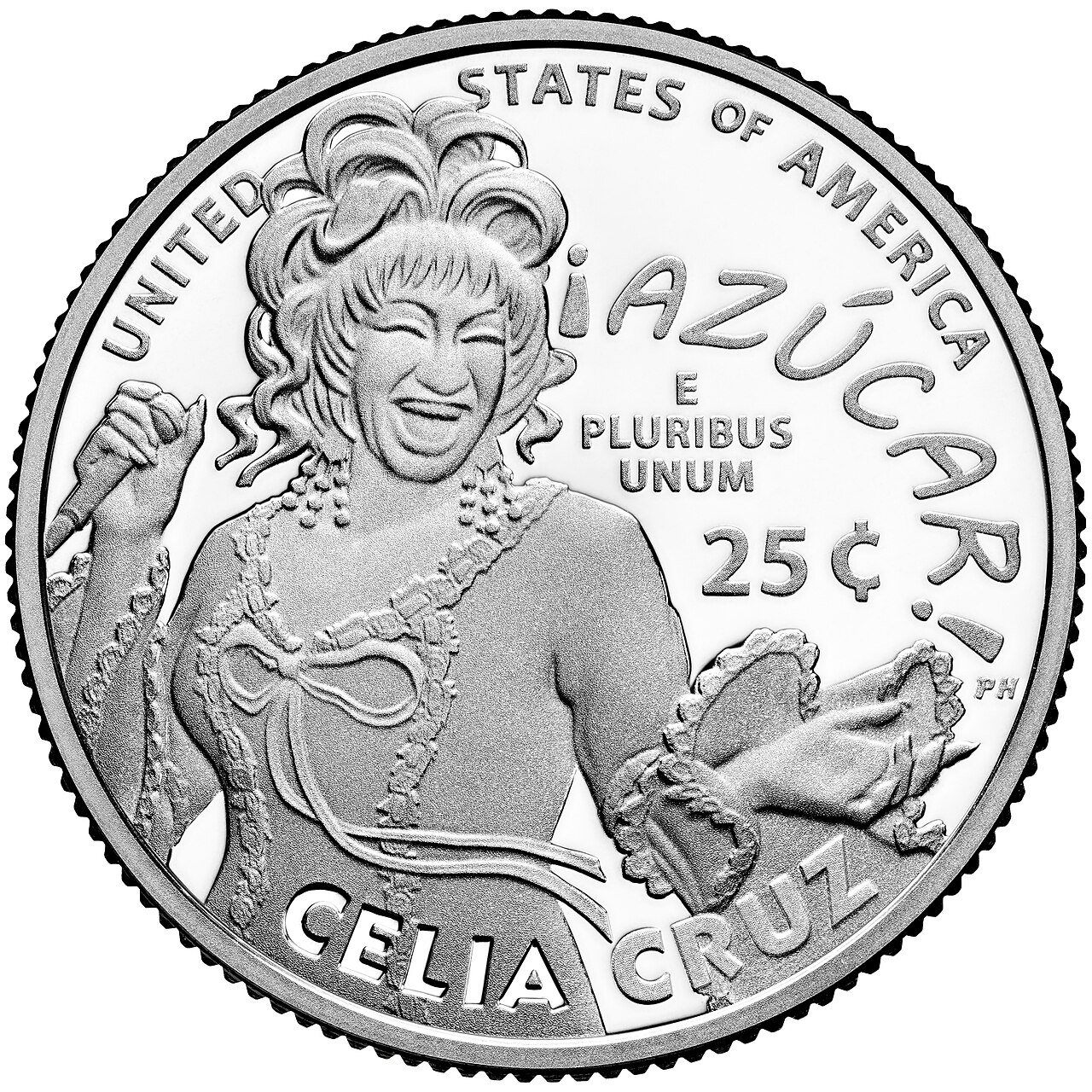 Cruz featured on a 2024 American Women quarter On 18 May 2005, the National Museum of American History, administered by the Smithsonian Institution and located in Washington, D.C., opened "¡Azúcar!", an exhibit celebrating the life and music of Celia Cruz. The exhibit highlights important moments in Cruz's life and career through photographs, personal documents, costumes, videos, and music. Her biography Celia: Mi vida was also published in 2005, based on more than 500 hours of interviews with the Mexican journalist Ana Cristina Reymundo. The journalist and TV presenter Cristina Saralegui planned to take the story of her life to the cinema and the American actress Whoopi Goldberg, admirer of the singer, expressed her interest in representing her, but the project was cancelled.[55] From 26 September 2007 to 25 May 2008, Celia, a musical based on the life of Celia Cruz, played at the Off-Broadway venue New World Stages. The show won four 2008 HOLA Awards from the Hispanic Organization of Latin Actors.[56] On 16 March 2011, Celia Cruz was honored by the United States Postal Service with a commemorative postage stamp.[57] The Cruz stamp was one of a group of five stamps honoring Latin music greats, also including Selena, Tito Puente, Carmen Miranda, and Carlos Gardel. The Smithsonian's National Museum of American History collaborated with photographer Robert Weingarten to create an object-based portrait of Celia Cruz featuring artifacts in the museum. The portrait was unveiled on 3 October 2012.[58] On 21 October 2013, Google honored her with a Google Doodle.[59] Jennifer Lopez honored Cruz with her presentation at the 41st American Music Awards ceremony.[60] The singers Yuri, La India, Maluma and Aymée Nuviola did the same at the Latin American Music Awards. Also in 2013, Cruz was inducted into the New Jersey Hall Fame.[59] In October 2015, Telemundo premiered an 80-episode docu-drama based on Cruz's life, Celia.[61] In 2015, the television networks RCN Televisión and Telemundo produced the TV series Celia based on the life of Crus. Cruz was played by the actresses Jeimy Osorio and Aymée Nuviola and counted on the voice of Patty Padilla.[61] In 2019, Angélique Kidjo released a tribute album to Cruz, entitled Celia, including songs spanning all of Cruz's career reinvented with an Afrobeat feel. It features Tony Allen (musician), Meshell Ndegeocello and the Gangbé Brass Band.[62] In 2018, a monument to Cruz was unveiled in the Cuban Heritage Park in Hialeah, Florida.[63][64] Also in 2018, the Celia Cruz Estate launched a brand inspired by Cruz which featured merchandise inspired and about Cruz.[65] In 2019, Chilean-American poet Marjorie Agosin created a chamber music theatre performance titled "Las Magníficas" (The Magnificent Ones), based on the life of Celia Cruz and Chilean singer-songwriter Violeta Parra.[66][67] On 2 June 2021, New York City honored Celia Cruz by co-naming the intersection of Reservoir Avenue and East 195th Street in the Kingsbridge Heights section of The Bronx, near the high school that is the named in her honor, "Celia Cruz Way".[68][69] Los Angeles has also named the intersection of Hollywood Boulevard and Argyle Avenue after her.[citation needed] In 2023, Rolling Stone ranked Cruz at No. 18 on their list of the 200 Greatest Singers of All Time.[70] In February 2023, Cruz was selected as an honoree in the 2024 American Women quarter program, making her the first Afro-Latina to appear on a U.S quarter.[71][72] |
 クルスが2024年のアメリカ女性クォーターに採用される 2005年5月18日、ワシントンD.C.にあるスミソニアン博物館が運営する国立アメリカ歴史博物館は、リア・クルスの人生と音楽を讃える展示 「¡Azúcar!」をオープンした。この展示では、写真、人格資料、衣装、ビデオ、音楽を通して、クルスがその人生とキャリアにおいて重要な瞬間にス ポットを当てている。彼女の伝記『Celia: 2005年には、メキシコのジャーナリスト、アナ・クリスティーナ・レイムンドとの500時間を超えるインタビューに基づいた『Celia: Mi vida』も出版された。ジャーナリストでテレビ司会者のクリスティーナ・サラレギは、彼女の半生を映画化することを計画し、セリア・クルスを敬愛するア メリカの女優ウーピー・ゴールドバーグは、彼女の代理人を務めることに興味を示したが、プロジェクトは中止された[55]。2007年9月26日から 2008年5月25日まで、セリア・クルスの半生を題材にしたミュージカル『セリア』がオフ・ブロードウェイのニュー・ワールド・ステージズで上演され た。このショーは、ラテン俳優のヒスパニック組織による2008年HOLA賞を4つ受賞した[56]。 2011年3月16日、セリア・クルスは米国郵政公社から記念切手で表彰された[57]。クルス切手は、セレーナ、ティト・プエンテ、カルメン・ミラン ダ、カルロス・ガルデルなど、ラテン音楽の偉人を称える5つの切手グループのうちの1つである。スミソニアン国立アメリカ歴史博物館は、写真家のロバー ト・ワインガーテンと共同で、博物館に所蔵されている工芸品を使ったセリア・クルスのオブジェ・ポートレートを制作した。この肖像画は2012年10月3 日に公開された[58]。 2013年10月21日、GoogleはGoogle Doodleでクルスを称えた[59]。 第41回アメリカン・ミュージック・アワードの授賞式では、ジェニファー・ロペスがクルスを称えた。また2013年、クルスはニュージャージーの殿堂入り を果たした[59]。 2015年10月、テレムンドはクルスの人生を題材にした80話のドキュメントドラマ『セリア・クルス』を初放送した[61]。 2015年、テレビネットワークRCN TelevisiónとTelemundoは、クルスの人生を基にしたテレビシリーズ『Celia』を制作した。クルスは女優のジェイミー・オソリオとア イメ・ヌビオラが演じ、パティ・パディージャの声をあてがった[61]。 2019年、アンジェリーク・キジョはクルスへのトリビュート・アルバム『セリア・クルス』をリリースした。このアルバムにはトニー・アレン(ミュージ シャン)、メシェル・ンデゲオチェロ、ギャングベ・ブラス・バンドが参加している[62]。 2018年、フロリダ州ハイアリアのキューバ・ヘリテージ・パークにクルスの記念碑が除幕された[63][64]。 また2018年、セリア・クルス・エステートはクルスにインスパイアされたブランドを立ち上げ、クルスにインスパイアされた商品やクルスに関する商品を紹 介した[65]。 2019年、チリ系アメリカ人の詩人マージョリー・アゴシンは、セリア・クルスとチリのシンガーソングライター、ヴィオレタ・パラの人生を題材にした 「Las Magníficas(The Magnificent Ones)」と題する室内楽劇を創作した[66][67]。 2021年6月2日、ニューヨーク市はセリア・クルスに敬意を表し、ブロンクス区のキングスブリッジ・ハイツ地区にあるレザボア・アヴェニューと東195 丁目の交差点を、セリア・クルスにちなんで「セリア・クルス・ウェイ」と命名した[68][69]。ロサンゼルスもハリウッド・ブルヴァードとアーガイ ル・アヴェニューの交差点をセリア・クルスにちなんで命名した[要出典]。 2023年、ローリング・ストーン誌はクルスを「史上最も偉大なシンガー200人」の18位にランクインさせた[70]。2023年2月、クルスは 2024年のアメリカ女性クォーター・プログラムの被表彰者に選ばれ、アメリカのクォーターに登場した初のアフロ・ラティーナとなった[71][72]。 |
| Discography Cruz recorded with Seeco Records through 1965 and with Tico Records from 1966 through 1972. Later, she recorded with Vaya Records and with its parent company, Fania Records. Cuba's Foremost Rhythm Singer (1958) Incomparable Celia (1958) Mi Diario Musical (1959) Con Amor (Exito, 1960) Canciones Premiadas (1961) Homenaje a Los Santos (1964) Canciones que Yo Quería Haber Grabado Primero (1965) Sabor y Ritmo de Pueblos (1965) Cuba Y Puerto Rico Son (1966) Son con Guaguancó (1966) Bravo Celia Cruz (1967) A Ti México (1967) Excitante (1968) Serenata Guajira (1968) Quimbo Quimbumbia (1969) Etc. Etc. Etc. (1970) Celia y Tito Puente en España (1971) Celia Cruz/Tito Puente Algo Especial Para Recordar (1972) Celia & Johnny (1974) Tremendo Caché (1975) Recordando El Ayer (1976) Only They Could Have Made This Album (1977) Homenaje A Beny More (1978) Celia Cruz Y La Sonora Ponceña La Ceiba (1979) Celia/Johnny/Pete (1980) Celia & Willie (1981) Feliz Encuentro (1982) Tremendo Trío (1983) Candela (1986) De Nuevo (1986) Winners (1987) Ritmo en el Corazón (1988) Guarachera del Mundo (1990) Canta Celia Cruz (1991) Reina del Ritmo Cubano (1991) Tributo a Ismael Rivera (1992) Verdadera Historia (1992) Azucar Negra (1993) Boleros Polydor (1993) Homenaje a Beny Moré, Vol. 3 (1993) Introducing (1993) Guaracheras de La Guaracha (1994) Homenaje a Los Santos (1994) Irrepetible (1994) Mambo del Amor (1994) Merengue Saludos Amigos (1994) Cuba's Queen of Rhythm (1995) Double Dynamite (1995) Festejando Navidad (1995) Irresistible (1995) Celia Cruz Delta (1996) Cambiando Ritmos (1997) Duets (1997) También Boleros (1997) Afro-Cubana (1998) Mi Vida Es Cantar (1998) En Vivo C.M.Q., Vol. 4 (1999) En Vivo C.M.Q., Vol. 5 (1999) En Vivo Radio Progreso, Vol. 1 (1999) En Vivo Radio Progreso, Vol. 2 (1999) En Vivo Radio Progreso, Vol. 3 (1999) Celia Cruz and Friends: A Night of Salsa (1999) Habanera (2000) Salsa (2000) Siempre Viviré (2000) La Negra Tiene Tumbao (2001) Hits Mix (2002) Unrepeatable (2002) Homenaje a Beny Moré (2003) Regalo del Alma (2003) Dios disfrute a la Reina (2004) Havana Nights (2019) |
ディスコグラフィー クルスは1965年までシーコ・レコードで、1966年から1972年まではティコ・レコードでレコーディングを行なった。その後、彼女はヴァヤ・レコードとその親会社であるファニア・レコードでレコーディングを行なった。 キューバ随一のリズム歌手(1958年) 比類なきセリア(1958年) 私の音楽の日記(1959年) 愛を込めて(1960年) 受賞曲集(1961年) ロス・サントスへのオマージュ(1964年) 最初に録音したかった曲(1965年) Sabor y Ritmo de Pueblos (1965) Cuba Y Puerto Rico Son (1966) Son con Guaguancó (1966) Bravo Celia Cruz (1967) A Ti México (1967) Excitante (1968) Serenata Guajira (1968) Quimbo Quimbumbia (1969) Etc. Etc. Etc. (1970) Celia y Tito Puente en España (1971) Celia Cruz/Tito Puente Algo Especial Para Recordar (1972) Celia & Johnny (1974) Tremendo Caché (1975) Recordando El Ayer (1976) Only They Could Have Made This Album (1977) オメナ・モアへのオマージュ(1978年) セリア・クルス・イ・ラ・ソノーラ・ポンセーニャ・ラ・セイバ(1979年) セリア・クルス・イ・ジョニー・クリストファー・ピート(1980年) セリア・クルス・イ・ウィリー(1981年) フェリス・エンクエントロ(1982年) トレンディートリオ(1983年) カンデラ(1986年) デ・ヌエボ(1986年) ウィナーズ(1987年) リトモ・エン・エル・コラソン(1988年) グアラチェラ・デル・ムンド(1990年) カンタ・セリア・クルス(1991年) レイナ・デル・リトモ・クバーノ(1991年) トリブート・ア・イスマエル・リベラ(1992年) ベラダ・ヒストリア(1992年) アスカル・ネグラ(1993年) Boleros Polydor (1993) Homenaje a Beny Moré, Vol. 3 (1993) Introducing (1993) Guaracheras de La Guaracha (1994) Homenaje a Los Santos (1994) Irrepetible (1994) Mambo del Amor (1994) メレンゲ・サルー・アミーゴス(1994年) キューバの女王リズム(1995年) ダブル・ダイナマイト(1995年) フェステハンド・ナビダッド(1995年) イリッシスタ(1995年) セリア・クルス・デルタ(1996年) カンビアーンド・リトモス(1997年) デュエット(1997年) また、ボレロス(1997年) アフロ・クバーナ(1998年) ミ・ビダ・エス・カンタール(1998年) エン・ビボ・C.M.Q.、第4巻(1999年) エン・ビボ・C.M.Q.、第5巻(1999年) エン・ビボ・ラジオ・プログレソ、第1巻(1999年) En Vivo Radio Progreso, Vol. 2 (1999) En Vivo Radio Progreso, Vol. 3 (1999) セリア・クルスと仲間たち:サルサの夜 (1999) ハバネラ (2000) サルサ (2000) いつも生きていく (2000) ラ・ネグラ・ティエネ・トゥンバオ (2001) ヒット・ミックス (2002) アンリピーターブル (2002) ベニー・モレへのトリビュート (2003) ギフト・オブ・ザ・ソウル (2003) ゴッド・エンジョイ・ザ・クイーン (2004) ハバナ・ナイツ (2019) |
| Filmography Salón México (Mexico, 1950) Una gallega en La Habana (Mexico, 1952) ¡Olé... Cuba! (Mexico/Cuba, 1957) Affair in Havana (USA/Cuba, 1957) Amorcito Corazón (Mexico, 1960) Salsa (Documentary, 1976) Salsa (USA, 1988) "Fires Within" (USA, 1991) The Mambo Kings (USA, 1992) Valentina (TV) (Mexico, 1993) The Perez Family (USA, 1995) Luz Pat El alma no tiene color (TV) (Mexico, 1997) ¡Celia Cruz: Azúcar! (TV) (Tribute, USA, 2003) Soul Power (Documentary of Kinshasa, Zaire Music Festival 1974) (USA, 2008) CELIA, Celia Cruz Bio-Drama (2015 on Telemundo) |
フィルモグラフィ メキシコのサロン(1950年メキシコ) ラ・ハバナの少女(メキシコ、1952年) オレ... キューバ (メキシコ/キューバ、1957年) ハバナの情事(アメリカ/キューバ、1957年) アモルシート・コラソン(メキシコ、1960年) サルサ(ドキュメンタリー、1976年) サルサ(アメリカ、1988年) 「ファイヤーズ・ウィズイン(アメリカ、1991年) マンボ・キングス(アメリカ、1992年) ヴァレンティーナ(TV)(メキシコ、1993年) ペレス・ファミリー(アメリカ、1995年) Luz Pat エル・アルマ・ノー・ティエネ・カラー(TV)(メキシコ、1997年) セリア・クルス アズーカル!(TV)(トリビュート、アメリカ、2003年) Soul Power (Documentary of Kinshasa, Zaire Music Festival 1974) (アメリカ、2008) セリア・クルス バイオドラマ『CELIA』(2015年テレ朝系) |
| Awards |
受賞(省略)「セリア・クルス」を参照 |
| Honorific nicknames in popular music Music of Cuba History of Cuba Pedro Knight - Cruz's musician husband List of Cubans List of best-selling Latin music artists |
ポピュラー音楽における敬称 キューバの音楽 キューバの歴史 ペドロ・ナイト - クルスの音楽家の夫 キューバ人リスト ラテン音楽ベストセラーアーティスト一覧 |
| https://en.wikipedia.org/wiki/Celia_Cruz |
Cruz
in 1957
リ ンク
文 献
そ の他の情報
cc
Copyleft, CC, Mitzub'ixi Quq Chi'j, 1996-2099
☆
 ☆
☆